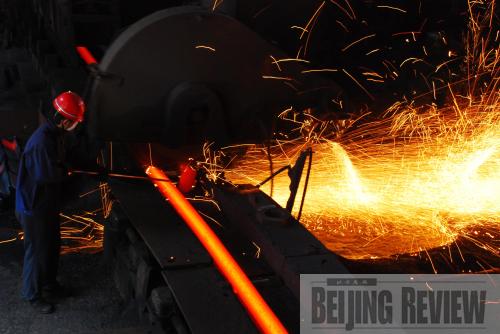|
 |
|
BIGGER AND STRONGER: Shandong Province is tightening efforts to strengthen its steel-making industry through mergers and acquisitions (CNSPHOTO) |
In a government effort to consolidate the crowded steel industry and position it for fierce global competition, the state-owned Shandong Iron and Steel Group officially agreed to merge with the private mill Rizhao Steel Holding Group Co. Ltd. on September 6.
Under the deal, Shandong Steel will pay cash for a 67-percent stake in the merged entity, leaving the remainder to Rizhao Steel's owner Du Shuanghua and other shareholders. After the merger, the Rizhao Steel will become a subsidiary of Shandong Steel.
The merger would boost Shandong Steel's annual output to 29.31 million tons, making it one of the largest steel producers only after Shanghai-based Baosteel Group Corp. and the Hebei Iron and Steel Group (HBIS), which registered an output of 35.44 million tons and 33.28 million tons, respectively, in 2008.
In terms of revenues, Shandong Steel would be able to pull ahead of HBIS to reach 167.7 billion yuan ($24.5 billion), second only to Baosteel which recorded revenues of 246.8 billion yuan ($36.1 billion) in 2008.
Shandong Steel was established via a merger between the Laiwu Steel Corp. and Jinan Iron and Steel Co. Ltd. last March. Rizhao Steel was a major private mill in the province, ranking among the top 10 steel-makers across the country.
Restructuring waves
A sweeping revamp is more than welcome to the Chinese steel industry. On top of the severe domestic downturn, steel mills have been reeling from market saturation as overcapacity drove down prices. Worse still, ever-intensifying competition is eating into their already narrow profit margins.
Since 2005 the country has stepped up efforts to sharpen the competitive edge of the sector. The government even mandated that the 10 largest steel producers must account for 50 percent of the country's total steel output by 2010, and 70 percent by 2020, up from 37.3 percent in 2005.
However, the consolidation seems to be easier said than done. Defying government efforts, the concentration rate has proceeded on a downward spiral from 34.6 percent in 2006 to 33.7 percent in 2007. According to estimates of China Iron and Steel Association, the steel capacity this year will amount to around 660 million tons, far in excess of market demands.
The Ministry of Industry and Information Technology said in a report that an effective solution to the tricky conundrum lies in mergers and acquisitions. The Central Government, earlier this year, introduced a detailed program to accelerate restructuring in the sector and support major players that can compete globally.
Since then a number of provinces have been riding the wave of steel regrouping.
With many weaker and smaller rivals being merged, the troubled industry is bound to find its feet despite the continuing economic gloom, said Hao Rongliang, a senior analyst with the Beijing-based Zhongshang Distribution & Productivity Promotion Center, in a recent report.
| 